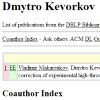| |
  
Steven M. Woolley,
David Posada and
Keith A. Crandall. A Comparison of Phylogenetic Network Methods Using Computer Simulation. In PLoS ONE, Vol. 3(4):e1913, 2008.
Keywords: abstract network, distance between networks, evaluation, median network, MedianJoining, minimum spanning network, NeighborNet, parsimony, phylogenetic network, phylogeny, Program Arlequin, Program CombineTrees, Program Network, Program SHRUB, Program SplitsTree, Program TCS, split decomposition.
Note: http://dx.doi.org/10.1371/journal.pone.0001913.
Toggle abstract
"Background: We present a series of simulation studies that explore the relative performance of several phylogenetic network approaches (statistical parsimony, split decomposition, union of maximum parsimony trees, neighbor-net, simulated history recombination upper bound, median-joining, reduced median joining and minimum spanning network) compared to standard tree approaches (neighbor-joining and maximum parsimony) in the presence and absence of recombination. Principal Findings: In the absence of recombination, all methods recovered the correct topology and branch lengths nearly all of the time when the subtitution rate was low, except for minimum spanning networks, which did considerably worse. At a higher substitution rate, maximum parsimony and union of maximum parsimony trees were the most accurate. With recombination, the ability to infer the correct topology was halved for all methods and no method could accurately estimate branch lengths. Conclusions: Our results highlight the need for more accurate phylogenetic network methods and the importance of detecting and accounting for recombination in phylogenetic studies. Furthermore, we provide useful information for choosing a network algorithm and a framework in which to evaluate improvements to existing methods and novel algorithms developed in the future. © 2008 Woolley et al."
|
|
| |
 
Lichen Bao and
Sergey Bereg. Clustered SplitsNetworks. In COCOA08, Vol. 5165:469-478 of LNCS, springer, 2008.
Keywords: abstract network, from distances, NeighborNet, realization, reconstruction.
Note: http://dx.doi.org/10.1007/978-3-540-85097-7_44, slides available at http://www.utdallas.edu/~besp/cocoa08talk.pdf.
Toggle abstract
"We address the problem of constructing phylogenetic networks using two criteria: the number of cycles and the fit value of the network. Traditionally the fit value is the main objective for evaluating phylogenetic networks. However, a small number of cycles in a network is desired and pointed out in several publications. We propose a new phylogenetic network called CS-network and a method for constructing it. The method is based on the well-known splitstree method. A CS-network contains a face which is k-cycle, k ≥ 3 (not as splitstree). We discuss difficulties of using non-parallelogram faces in splitstree networks. Our method involves clustering and optimization of weights of the network edges. The algorithm for constructing the underlying graph (except the optimization step) has a polynomial time. Experimental results show a good performance of our algorithm. © Springer-Verlag Berlin Heidelberg 2008."
|
|
|
 - forked on GitHub.
- forked on GitHub.






























